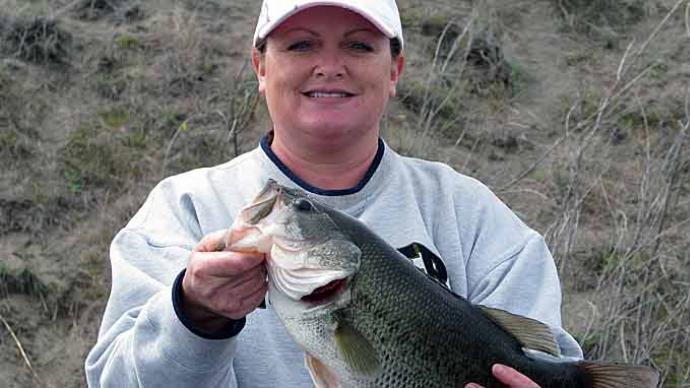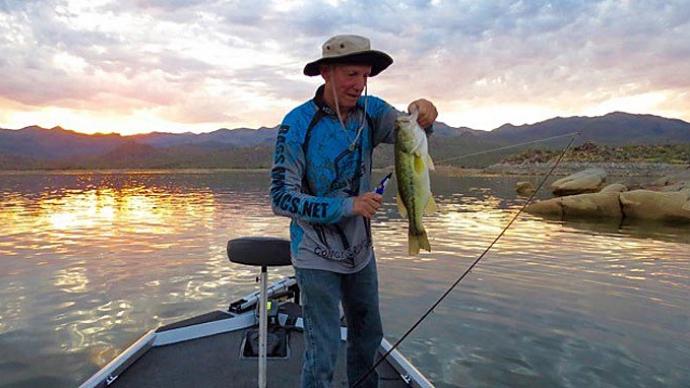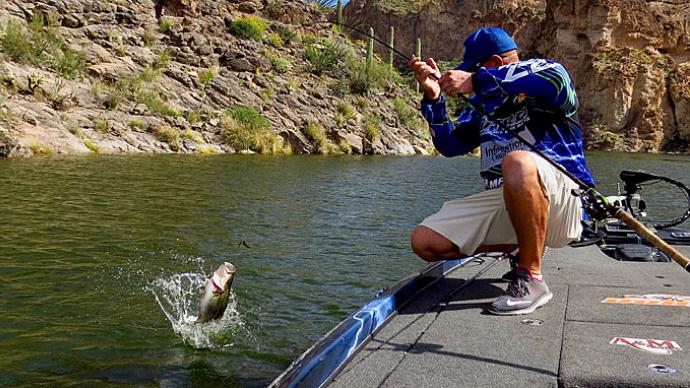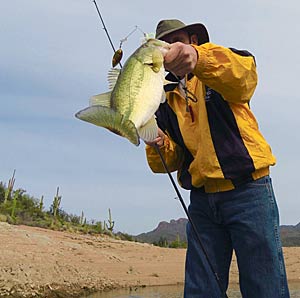
When you think of reaction baits, you probably think of guys like Gary Dobyns of California or Kevin VanDam. Both of these professional anglers have made tons of money throwing reaction baits. Back in the day, people called crankbaits “idiot baits” because they thought any idiot could catch a fish on them. That is true in a sense - eventually, if you throw enough times, you’ll probably catch a fish of some sort no matter how haphazard you are being. But guys like Dobyns and VanDam didn’t get rich and famous being haphazard, and crankbaits are not the only reaction baits around.
Gary Dobyns is the king of ripbaits. When he first started fishing, he says that the fish weren’t yet conditioned to jerk baits, so he chose the flashiest ones. His weapon of choice was a clown Rogue (still a killer bait, by the way). His gear back then was brutal - big heavy fiberglass rods that took some major muscle to wield all day. Gary’s a big boy, so that he could handle it. That alone gave him an edge.
The rods, reels, lines, and baits are vastly improved, but it still takes a little know-how to figure out how to put everything together and get a reasonable limit in the livewell. Gary says that with all the great equipment on the market today, anybody can rip all day.
A moderate-fast action rod is best for rippin’ because you want it to load up but not react too fast. You want a little forgiveness when you set the hook. Pair that up with a high-speed reel because a fast reel is a must so you can catch up with your bait on the pause. Gary now makes his line of rods, so you can be sure that a Dobyns Rod ripbait rod is perfect for jerkbaits.
“I throw rip baits twelve months a year, but the best time for them is winter and pre-spawn. I’ll start the year out throwing deeper-diving baits like Shad Raps or Staysee '90s, and as the water warms up, I switch to Rogues and Pointer 128s. Post-spawn bass react well to smaller, erratic lures like TD Minnows and Pointer 78s. In summer, I tend to go back to the deeper baits. The key is to pick the lure that will best fish the depth you want,” says Dobyns.
Use brighter colors like trout, chartreuse, and clown in the early morning and low-light conditions (overcast or windy). With a high, bright sky, you’ll want to change to more subtle colors like ghost minnow or clear baits without much reflection. Water color has an effect too. In darker water, use brighter baits; in clear water, go with the muted shades. Rippin’ is a sight technique - the fish have to be able to see the bait. But these days, you want them to see it as something natural.
Gary says he constantly changes out the hooks on rip baits. “Some Japanese baits are under-hooked, so I change the size 6 hooks to 4s,” he explains. “I put brand new Gamakatsu wide gap trebles on all my rip baits, and if they get dull during the day, I take a file to them or change the hooks out again.”
“People tend to get intimidated by ripping,” says Dobyns, “when actually, it’s the easiest thing. You can't go wrong if you’re jerking and pausing. I call it a bone-head technique. When you pause, make sure you put a little slack in the line so the bait goes dead. When it starts again, it looks like a wounded bait fish, and the bass can’t resist it. It’s a deadly tournament technique because you catch quality fish and numbers. I’ve caught six bass over 11 pounds rippin’ and one over 12. My son Richard was an accomplished ripper at five years old, and if a kid can do it, you can too. All you need is confidence, which will come from doing it.”
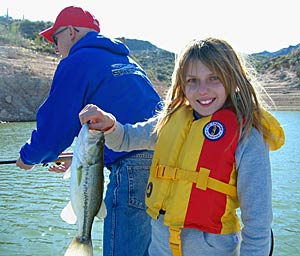
KIDS AND REACTION BAITS
When your kids or grandkids are just starting to learn to fish, it’s understandable to be reluctant to hand them a lure bristling with treble hooks. When there are two adults, a dog, and two kids in a boat, it can be downright dangerous. The trouble is, if there is a crankbait bite on, you don’t want the kids to miss out. As an alternative to the crankbait, why not try a small swimbait?
A recent visit to a tackle shop turned up tons of small swimbaits. Storm Lures makes some killer little WildEye swimbaits in various excellent colors. The single hook on these baits makes them much safer in inexperienced hands, but they still crank through the water like a plug. The Storm WildEye Swim Shad comes in several sizes, shapes, and colors. You can match every baitfish from shad to trout, and they’re easy to throw. Best of all, they catch fish. Try to get your little future bass pro to let them sink before reeling them in.
Spool the kids up with some of that Berkley FireLine Crystal, and they won’t lose so many baits. Just make sure that when they get snagged, YOU are the one to pull the lure loose. Braid can give little (and big) fingers severe injuries if you pull on it by hand, so wrap it around your pliers to pull it. Also, you’ll need some perfect sharp scissors to cut it. Clippers won’t do the trick. The advantage to braid is that you don’t lose so many lures, and it helps the bait work deeper. Big mono tends to float a bait a bit.
BLADE BAIT VARIATIONS
A spinnerbait is an excellent reaction bait, and even a child can throw one and catch fish on it. My granddaughter’s first fish came on a spinnerbait when she was a tyke. The typical spinnerbait with its single-arm, jig-like head and rubber or silicone skirt is what most people think of when they think of blade baits, but there are a lot of different kinds of them out there now.
The Chatterbait is a blade bait that has been widely copied. It’s a skirted jig with a weird little blade on the front that makes it wiggle and vibrates as you crank it. The Chatterbait (or knock-offs) has produced bass for us at just about every lake in Arizona.
Another spinnerbait variation is a lure designed by Stan Fagerstrom, the trick caster and outdoor writer. The lure is called, appropriately enough, the Stan Spin. What’s different about Stan’s spinnerbait is the back blade. It’s Mylar, and it looks like little wings attached to the arm in the center instead of on one end. The lightweight blade, Stan says, turns even at prolonged speeds, making it the ideal dropping helicopter bait. A Colorado blade in front of the Mylar gives the bait a thump that attracts even more. There’s also a little bit of flash in the skirt. The Stan Spin comes in a variety of sizes and skirt colors. Visit www.mackslure.com to see the full line, or call them at (509)667-9202.
McCoy, the guys who make the Mean Green fishing line, also have a spinnerbait variation. It’s called the V-Twin because it has two arms, each with its own spinnerbait blade. The two arms deliver twice the vibration and thump, and they also help the bait run true. The arms can be folded up to make them easier to store.
Don’t forget blade baits, like the Silver Buddy and the Little George. The Silver Buddy is the perfect lure to keep tied on and ready in case of boils. They cast a mile, and they’ll catch anything that swims. Silver Buddies come in sizes ranging from 1/8-ounce to a whopping four ounces. For kids or weeds, opt for the weedless version with single hooks and weed guards. In open water, or for more experienced casters, the double trebles are hard to beat.
How long has it been since you fished a Little George? It’s a simple teardrop-shaped chunk of metal with a spinning blade for a tail, but it will catch a ton of fish. You can get them in several colors (including holographic colors) and various sizes. They’re another lure that casts well.
Now is the time to get out on the water and do some fishing. Spring is hard to beat for active fish, so it’s also the perfect time to introduce someone to the joys of fishing. Grab a handful of reaction baits and get out there, and don’t be afraid to experiment with different lures.
BassResource may receive a portion of revenues if you make a purchase using a link above.


